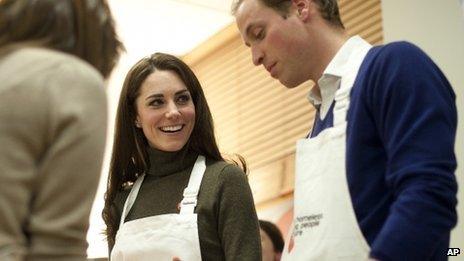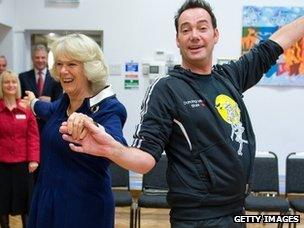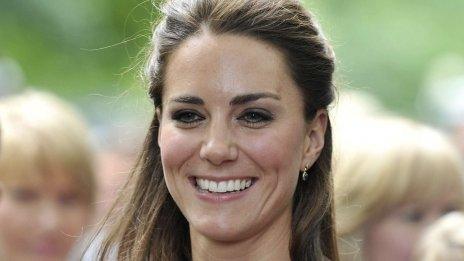Why do charities want a royal patron?
- Published

The Duchess of Cambridge, pictured above at a charity event, has become the patron of four charities
After much consideration, the Duchess of Cambridge has announced details of four charities of which she has chosen to become patron. But what does it mean to a charity to get a royal patron?
The practice of members of the Royal Family lending their names to organisations through formal patronages is thought to have been around for about three centuries.
According to the British Monarchy, the first recorded patronage was George II's involvement with the Society of Antiquaries, sometime in the 18th century.
But in recent years, the prevalence of patronages, particularly among charities, seems to have got more prolific.
Take the Queen, who has accepted more than 600 patronages, and the Duke of Edinburgh, who has accumulated 700.

The Duchess of Cornwall dancing with Craig Revel Horwood at an National Osteoporosis Society event
The Prince of Wales, for his part, has clocked up the title of patron or president of more than 400 organisations and set up the Prince's Trust.
So how beneficial is it for charities to have a royal figurehead?
The National Osteoporosis Society's Siobhan Hallmark says the charity has been "enormously fortunate" to have had Camilla, now the Duchess of Cornwall, as its president since 2001 because she has "worked tirelessly to raise awareness".
"Having watched her own mother suffer the painful and debilitating fractures caused by osteoporosis, she knows only too well the devastating effects of fragility fractures," she says.
Rob Cope, director of Remember A Charity, agrees that royal patrons are incredibly hard working and their status helps charities - who are vying for public money and media attention - raise their head above the parapet.
He thinks royals frequently have more credibility than celebrities, and are able to reach different demographics such as older generations.
Then there is the small factor of their connections, which can boost the bottom line.
"Whether it is engagements, events or theatres attendances, the royals draw in other well-connected donors and celebrities.
"There is no doubt that royals drive millions and millions of pounds to the charity sector every year," he says.
Taboo causes
Stephen Cook, the editor of Third Sector, a voluntary and not-for-profit sector magazine, says the value of royal patronage is unproven, but he cannot imagine that any charity would turn down a royal patron, certainly from a fund-raising point of view.
"It offers charities the opportunity to have event receptions at Buckingham Palace or Clarence House, which is very attractive, and they are often overflowing with high-profile attendees.
"In some cases it gives wealthy supporters of a charity an opportunity to meet the royal patron - that can be part of the pull, especially for supporters and donors," he says.

Prince Harry jointly founded Sentebale, a charity to help Lesotho orphans
Mr Cook concedes there is always the possibility some people, such as republicans, might be put off charities by a royal patron, but he believes they would be well outnumbered in Britain.
And he says some alliances are not always seen in a positive light.
"When Prince Andrew went through a tough time with the media, it was bound to have an effect to some extent on his attractiveness as a patron. When the Duchess of York was all over the tabloids the Motor Neurone Disease Association considered breaking with her," he says.
But Mr Cook says, in general, charities connected to the Royal Family are viewed as more trustworthy by the public because people think they will have done their due diligence.
In fact, he says research in the 2010 edition of the Charity Brand Index suggests that charities with the word royal in their headline - such as the Royal Society for the Prevention of Cruelty to Animals (RSPCA) and the Royal British Legion - are a "supercharged version of the royal patron" because they scored most highly on the trust index.
Prof Cathy Pharoah, co-director of the centre for giving and philanthropy at Cass Business School at City University, London, agrees that royal patronage changes the public perception of a charity.

Princess Diana visited Angola in 1997 to highlight the plight of landmine victims
"It's an endorsement that their work is reputable and high quality," she says, adding that royal patrons are highly sought-after.
Another benefit is royals have increasingly got involved with new charities or causes that struggle to attract mainstream attention, she says.
"The Princess of Wales championed Aids, which was a bit of a taboo, and landmines, which was a lesser-known cause, while William and Kate's charitable gift fund had little-known charities and focused on young people, children in care and carers and bullying."
There is also evidence to suggest royal patronage can lead to a growth in public support, she argues.
She cites the Charity Market Monitor, which studies the annual finances of the top 500 charities. It showed the fund-raised income of the top services/ex-services charities from the public grew by a real 6.2% in 2009-10, compared with an average fall of -1.1%.
Prof Pharoah says: "The support of the royal princes for services and ex-services charities has been hugely important. Those areas were very much seen as a legacy of the past, but they've brought a new awareness to it and made it a more immediate cause.
"It was like when William and Kate chose charitable causes as part of their wedding celebrations, they chimed in with the mood of the moment."
Whether Kate has struck a chord with her choice of royal patronages remains to be seen.
- Published5 January 2012
